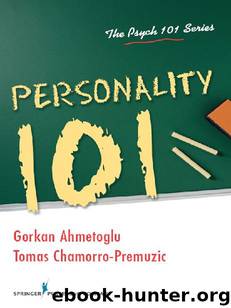Personality 101 (Psych 101) by Gorkan Ahmetoglu PhD & PhD Chamorro-Premuzic Tomas

Author:Gorkan Ahmetoglu PhD & PhD Chamorro-Premuzic Tomas [Ahmetoglu PhD, Gorkan]
Language: eng
Format: epub
Publisher: Springer Publishing
Published: 2012-09-10T04:00:00+00:00
TESTING PERSONALITY THEORIES: CORRELATION, REGRESSION, AND STRUCTURAL EQUATION MODELING
The beginnings of personality research were characterized by the use of precarious methods of data collection and personality theories were often derived from introspection, observations, and case studies. However, modern approaches to personality can be distinguished from such theoretical or speculative approaches in that they are based on systematic gathering and analysis of quantitative data. As discussed in Chapter 1, dispositional theories of personality were derived from large datasets, which were generated by the use of self-report inventories. Accordingly, theories and hypotheses about the relationship between personality and various life outcomes can be examined through statistical tests, such as Pearson’s correlation coefficients (see below). This systematic and predominantly quantitative process enables researchers to validate personality inventories and, consequently, test personality theories (or models). Below, we outline some of the more basic, as well as the more complex, statistical methods of data analysis used by personality psychologists.
Correlation
The statistical test of correlation is widely employed to assess the extent to which two variables are related to each other. The most widely used correlational test is the Pearson Product–Moment Correlation Coefficient, simply known as the Pearson correlation. This coefficient is represented by the lower-case letter r and takes its name from Karl Pearson (1857–1936), a famous British statistician. Although Sir Francis Galton may be credited with developing the theory of correlation in 1888 (Galton, 1888), Pearson’s (1896) statistical test was one of the first to provide robust scientific instruments for the study of individual differences.
In simple terms, the Pearson correlation is a measure of the extent to which two variables (e.g., x and y) change together. It assesses whether (and to what extent) changes in one variable are predictable by changes in the other. For instance, when people make statements such as “the more you exercise the better you feel,” “nice guys finish last,” or “the less you drink the less you get in trouble,” they are inferring correlations between variables. That is, in each of these statements it is hypothesized that one variable is predictable on the basis of the other. For instance, in the first statement, as one variable (exercise) increases so does the other (feeling well); in the second, as one variable (niceness) increases the other decreases (probability of attracting a female mate); and in the third, as one variable decreases (drinking) so does the other (getting in trouble).
Correlations can also be distinguished on the basis of their direction—positive or negative, ranging from –.1 to +.1. In the above statements, the first and the last are positive. The first, because both increase together, and the last because both decrease together (the product of two negative numbers is always positive). The second is negative because the variables are inversely related. The name negative correlation can sometimes be misleading, commonly interpreted as meaning no correlation. No correlation is, however, when the two variables are not related at all; that is, changes in one variable are not predictable from changes in another. For instance, two unrelated variables may be running speed and Extraversion.
Download
This site does not store any files on its server. We only index and link to content provided by other sites. Please contact the content providers to delete copyright contents if any and email us, we'll remove relevant links or contents immediately.
Rewire Your Anxious Brain by Catherine M. Pittman(18554)
Talking to Strangers by Malcolm Gladwell(13225)
The Art of Thinking Clearly by Rolf Dobelli(10228)
Mindhunter: Inside the FBI's Elite Serial Crime Unit by John E. Douglas & Mark Olshaker(9206)
Becoming Supernatural by Dr. Joe Dispenza(8123)
Change Your Questions, Change Your Life by Marilee Adams(7637)
Nudge - Improving Decisions about Health, Wealth, and Happiness by Thaler Sunstein(7622)
The Road Less Traveled by M. Scott Peck(7523)
The Lost Art of Listening by Michael P. Nichols(7409)
Enlightenment Now: The Case for Reason, Science, Humanism, and Progress by Steven Pinker(7239)
Mastermind: How to Think Like Sherlock Holmes by Maria Konnikova(7229)
Win Bigly by Scott Adams(7095)
The Way of Zen by Alan W. Watts(6509)
Daring Greatly by Brene Brown(6449)
Big Magic: Creative Living Beyond Fear by Elizabeth Gilbert(5615)
Grit by Angela Duckworth(5525)
Ego Is the Enemy by Ryan Holiday(5295)
Men In Love by Nancy Friday(5158)
Altered Sensations by David Pantalony(5046)
